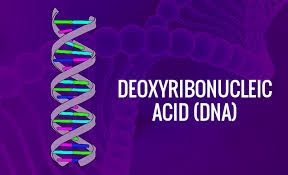Structures of DNA, RNA and differences between DNA & RNA
Deoxyribonucleic Acid (DNA)
DNA is a molecule which contains instructions which any lifeform needs to live, grow, function and propagate. They are present inside each cell of the body and are passed on from one generation to the next. Each DNA molecule is made up of nucleotides containing a sugar group, a phosphate group, and nitrogen bases. There are four nitrogen bases- Adenine (A), Thymine (T), Guanine (G) and Cytosine (C). The instructions to be followed are determined by the specific order of these nitrogen bases.
Structure of DNA
- DNA is structured in a double helix pattern and can be imagined as a twisted ladder.
DNA molecule is made up of nucleotides containing a sugar group, a phosphate group, and nitrogen bases.
- The sugar and phosphate group form the sides of the ladder while the rungs are the nitrogen bases.
- The bases on one strand pair with another- Adenine with Thymine (A-T) and Guanine with Cytosine (G-C).
Function of DNA
The order of nitrogen bases in a stretch of DNA contains instructions for cells to make a specific protein. It is called a gene. DNA thus is the blueprint of all the genetic information that an organism needs for protein synthesis.
Ribonucleic acid (RNA)

It is crucial in the process of protein synthesis as the flow of genetic information in a cell from DNA to protein is mediated by RNA. When a cell needs to make a certain protein, it activates the portion in DNA with the protein code. “DNA photocopies” which are messenger RNA or mRNA are made which translate the code into the protein through ribosomes.
Ribosomes are the protein synthesis units of the cells.
There are many kinds of RNA discovered which work as
- Translators of genetic information during protein syntheses like the mRNA, rRNA, and tRNA.
- Regulators of gene activity like Small Interfering RNA or siRNA, microRNA or miRNA.
- Processors to process other RNA’s like Small nucleus RNA or snRNA.
Difference between DNA and RNA
DNA and RNA are structurally very similar except three fundamental differences:
- They both have sugar, phosphate groups and nitrogen bases. But DNA has deoxyribose sugar while RNA has ribose sugar.
- Thymine (T) in DNA is replaced by Uracil (U) in RNA. Adenine is paired with Uracil in RNA (A-U).
Click here to read about Blood Circulation
- RNA has a single strand in its molecule structure while DNA is double-stranded.
Top GK Website for Competitive Exam
]]>




